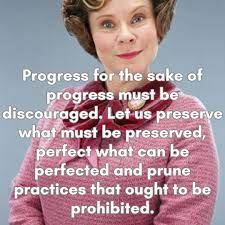Can innovation be non-critical?
Retroactive Manifestos seem to me to be more concerned with creativity than innovation. The innovation they value is more aesthetic, cultural, or structural, which are surface level or superfluous considerations that may be new and exciting, but do not make deep or meaningful changes. To really be innovative, I believe there must be meaningful progress to the given discipline or object. The definition of progress may be debated, and I don't have an answer as to what progress is at it's core, whether it must always be 'forward' or improving, on what timescale, or who determines that. I would however, argue that progress can be defined at least in part by what it is not. Progress necessarily means not maintaining the current status quo.
While the first three of the four points that define retroactive manifestos - specific, ordinary, and liberating - seem like they would value and inspire true innovation, and in some ways create it by expanding what gets included within the field of architecture, the fourth - non-critical - seems to actively counteract any true innovation or progress. One of the core defining features of this perspective is to be non-critical in not challenging the social order, being non-utopian, and even essentially arguing that architecture cannot be utopian or create meaningful social change. While the Modernists were overly prescriptive and elitist (not to mention that many, if not most of them were hugely problematic on an individual scale), they were attempting to change the world for the better. While looking down their noses at the 'common man,' they were still trying to create something that would benefit everyone, including the 'common man.' Meanwhile, the retroactive manifesto approach is contextual and more accessible to people, trying to change the definition of architecture to include every level and give them all the same respect and rigor, yet they have given up on any possibility of improving the world. They will look at this 'low' or 'common' architecture and raise it to a level of consideration and import, but not challenge the systems and ideas that have made it or that continue to shape it. It's exceedingly puzzling to me and it makes it difficult for me to understand their underlying goals or even, to some degree, what exactly they are trying to say. What is this approach at its core and is this something that I agree with? Or is it yet another architectural movement in which I must simply tolerate the ideas and people driving it and their impact of the field, despite my distaste and disappointment in their values and/or actions and the direction they pushed the discipline of architecture?



I don't know if creativity and innovation can always meet together in architecture, but I believe that innovation doesn't meet limitations. This is what happens with different architectural movements when they start to dream about the future of architecture, and there are always innovations coming with the dreams.
ReplyDeleteYour discussion on progress is insightful and I think the critique of retroactive manifestos not seeking to make meaningful commentary is valid, however I think their hesitance to use architecture as the sole method of bringing about social change allows us to really consider design’s capacity to evoke social change. While from our perspective their refusal is disappointing, I think it has open discourse to consider the role of the architect socially, rather than us falling into a practice of just endlessly creating different utopias
ReplyDelete